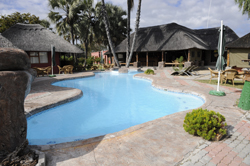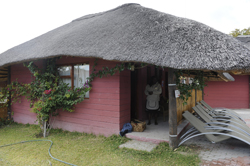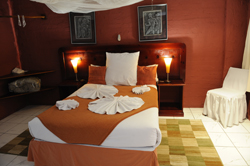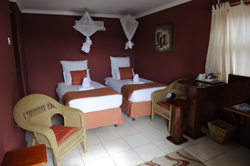Chalet
- Single beds
- Bathroom/Shower
- Television
- Tea kettle
- Mosquito Net
- Ceiling fan

Situated in the heart of Nata, amongst a forest of Ilala Palms en route to the Okavango Delta or Chobe Game Reserve this is the ideal stop over after a long journey, or a great way to start a new adventure. Alternatively, make us your base to spend your days exploring the plentiful places of interest in this vast, untapped beauty of Botswana, including game viewing, bird watching, camping, and much, much more.
Discounts may be available for children sharing with adults, please specify the ages and number of children when making your booking or requesting a quote.
| January 2025 - December 2025 | ||
|---|---|---|
| Accommodation | Per Person Sharing | Single Rate |
| Double Room | Please Enquire | Please Enquire |
| Camping | Per Person Sharing | |
| Camping | Please Enquire | |
General text about the accommodation. Introduction to what type of accommodation is offered at Northgate Lodge and any particular selling points. Highligh standard facilities available in all room types, for example fans, air-conditioning or tea and coffee stations.



Enjoy five star European style cuisine (or be adventurous and try the fantastic traditional cuisine), ice cold drinks from the fully stocked bar, or just relax by the cooling waters of our sparkling pool.
The Makgadikgadi Pan is a large salt pan in Northern Botswana, the largest salt flat complex in the world. These salt pans cover 16,000 km2 (6,177.6 sq mi) and form the bed of an ancient lake that started evaporating 10,000 years ago.
The area is home to one of Africa's biggest zebra populations, and usually only quad bikes are permitted on the fragile plains in single file. Makgadikgadi is technically not a single pan but many pans with sandy desert in between, but it is all counted in the area estimate.
The largest individual pan is about 5,000 km2 (1,930.5 sq mi), and it is frequently covered with water. Salar de Uyuni in Bolivia on the other hand is a single salt flat of 10,582 km2 (4,085.7 sq mi) and rarely has much water and is also claimed to be the world's largest salt pan. Commercial operations to mine salt and soda ash began in 1991. The main water source is the Nata River, called Amanzinyama in Zimbabwe where it rises at Sandown about 60 km (37.3 mi) from Bulawayo. Kubu Island, a rock island, is within the Makgadikgadi Pan.
This sanctuary was established in the early 1990s on the far northeastern edge of Sowa Pan and, apart from the Makgadikgadi and Nxai Pan National Park, is the only protected reserve in the area.
It is a local community project managed by a board of trustees selected from four nearby villages. This 230 sq km community project is designed as a refuge for the wildlife on and around Sua Pan (45% of the reserve is in the pan).
The idea was first raised in 1988 by the Nata Conservation Committee and the sanctuary was released four years later, thanks to the Kalahari Conservation Society and funding from national and international organisations. Local people voluntarily relocated 3,500 cattle onto adjacent rangeland and established a network of dust roads. This unique approach to community involvement in ecotourism is considered to be the key to conservation throughout Africa.
Two places of historical interest are Green's Baobabs and Chapman's Baobabs. Traders and explorers flocked to the area and amongst them were Anderson, Cummings, the Green brothers, Chapman and Baines. One of the major routes for these traders and explorers ran through the narrowest section of Ntwetwe pan. The only evidence of the hustle and bustle of early traders, explorers, missionaries and thieves are the names inscribed on the Baobab trees.
The growth of the trees have obscured many of the names, but on Green's Baobab "Green's Expedition, 1858-1859" is clearly visible. Approximately 11 kilometers South of this enormous baobab is a magnificent, seven stemmed baobab tree known as Chapman's Baobab or the Seven Sisters. There are a multitude of names on this tree, and Chapman's name is indicated by his initials "J.C.". This colossal specimen, visible from great distances across the pan, is worth seeing if only because of its size and photogenic qualities. It was used as a landmark for the early explorers of the region.
About 11km further south of Green's Baobab is the turn-off to the far more impressive Chapman's Baobab, which has a circumference of 25m and was historically used as a navigation beacon. It may have also been used as an early post office by passing explorers, traders and travellers, many of whom left inscriptions on its trunk.
In the middle of Ntwetwe, on the west of the usual north south route across the pans, Gabasadi Island is a low mound protruding from the surface of the pan. It's actually a fossilised, crescent-shaped barchan dune, which you'll realise if you climb it.
Rising no more than 20m above the Sowa Pan, this national monument with its fossil beaches, stunted baobab trees and mysterious stone walls, leaves an indelible impression upon all who visit its water-worn shores. This scrap of rock and its ghostly baobab trees is surrounded by the sea of salt.
In cool weather, this bizarre sight can make visitors feel like castaways on an alien planet. The real name of the island, but less known, is Lekhubu (meaning ridge in Setswana). It is the most famous of all the rock islands in the Makgadikgadi.
Most of the rock islands in this area are remnants of ancient sand dunes. Kubu Island is different in that it is one of the scatterings of granite islands. Many of Kubu's rocks are stained white with fossilized bird droppings. This ancient guano is called apatite and bears testimony to a large bird population that used to live on the island, feeding off the fish of the waters that surrounded their rocky knoll.
There is a trig-beacon on the island's summit. The rocks on the northeastern side are all smoothed by wave action, while on the opposite leeward side are thousands of small, rounded pebbles, which used to protrude as a tiny wave-washed beach.
As the level of this immense inland sea rose and fell, there were times when Kubu was deep beneath the waves, others when it lay exposed in a sea of sand and others when it hardly showed above the surface, surrounded by 100 km of sea. The island is littered with artifacts from other ages: Stone-Age cutting tools, shards of pottery at least 2000 years old, and the remains of a low, circular wall.
See the Kgotla, have traditional Magunya made for you, see the clinic and school, and ride in a donkey cart.